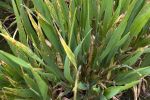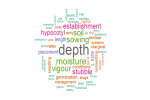Agriculture Victoria is working with the South Australian Research and Development Institute’s Climate Applications research group led by Dr Peter Hayman to better predict disease risk in lentils.
Team member Bronya Cooper explains there are differences between a pathologist’s measurement of the canopy’s microclimate when considering disease severity risks and the way weather data is collected and forecasts made by the Bureau of Meteorology (BoM).
We are exploring opportunities to close the forecast gap for disease risk by monitoring trial sites with sensors that span the spectrum from canopy to weather station.
This involves a three-tiered approach to data collection:
- in-crop, canopy-level Tinytag sensors;
- edge-of-paddock sensors at a BoM-standard height of 1.2 metres; and
- data collected from the nearest BoM weather station to the trial site.
The focus is on temperature and humidity readings.
The aim is to use the in-crop dataset to identify patterns that are indicative of disease occurrence and severity.
The climate team will then run comparative studies across datasets to identify signals in weather station data that are correlated to the patterns associated with disease risk.
Furthermore, the historical record of daily data will be used to place the experimental year in context (for example, 70th percentile rain days in spring) and enable comparison between sites (for example, how does a wet year in one location compare to a normal year in another?).
The team will then begin to develop simple economic frameworks based on crop protection management decisions and coordinate activities with the GRDC National Risk Management Initiative (RiskWi$e).
A better understanding of how standard BoM measurements are linked to disease could see better use of BoM data, avoiding the need for in-crop sensors that interfere with the operation of farm machinery.
“Given that the broader team is defining thresholds with regards to the economics of preventive spraying, the added ability to assess climatic conditions adds an extra layer of capability when it comes to decision-making around disease control,” Ms Cooper says.
More information: Bronya Cooper, bronya.cooper@sa.gov.au
Nicole Dron, nicole.dron@dpi.nsw.gov.au
Aaron Vague, aaron.vague@faraustralia.com.au

























































